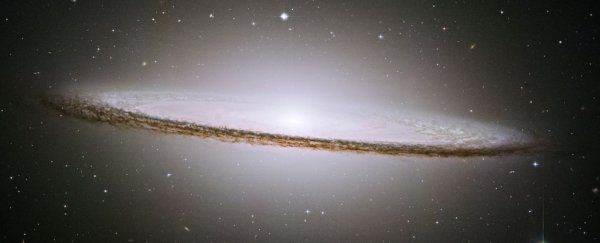We may not know what dark matter is, but scientists now have a better idea of what to look for.
Based on quantum gravity, physicists have worked out new, much more stringent upper and lower mass limits of dark matter particles. And they have found that the mass range is way tighter than previously thought.
This means that the dark matter candidates that are either extremely light or heavy are unlikely to be the answer, based on our current understanding of the Universe.
"This is the first time that anyone has thought to use what we know about quantum gravity as a way to calculate the mass range for dark matter. We were surprised when we realised no-one had done it before - as were the fellow scientists reviewing our paper," said physicist and astronomer Xavier Calmet of the University of Sussex in the UK.
"What we've done shows that dark matter cannot be either 'ultra-light' or 'super-heavy' as some theorise - unless there is an as-yet unknown additional force acting on it. This piece of research helps physicists in two ways: it focuses the search area for dark matter, and it will potentially also help reveal whether or not there is a mysterious unknown additional force in the Universe."
Dark matter is undeniably one of the biggest mysteries of the Universe as we know it. It's the name we give to a mysterious mass responsible for gravitational effects that can't be explained by the stuff we can detect by other means - the normal matter such as stars, dust, and galaxies.
For example, galaxies rotate much faster than they should if they were just being gravitationally influenced by the normal matter in them; gravitational lensing - the bending of spacetime around massive objects - is far stronger than it should be. Whatever is creating this additional gravity is beyond our ability to detect directly.
We know it only by the gravitational effect it has on other objects. Based on this effect, we know there is a lot of it out there. Roughly 80 percent of all matter in the Universe is dark matter. It's called dark matter because, well, it's dark. And also mysterious.
However, we do know that dark matter interacts with gravity, so Calmet and his colleague, physicist and astronomer Folkert Kuipers of the University of Sussex, turned to the qualities of quantum gravity to try and estimate the mass range of a hypothetical dark matter particle (whatever it may be).
Quantum gravity, they explain, places a number of bounds on whether dark matter particles of various masses can exist. While we don't have a decent working theory that unites general relativity's space-bending description of gravity with the discrete chunkiness of quantum physics, we know any melding of the two would reflect certain fundamentals of both. As such, dark matter particles would have to obey quantum gravitational rules on how particles break down or interact.
By carefully accounting for all these bounds, they were able to rule out mass ranges unlikely to exist under our current understanding of physics.
Based on the assumption that only gravity can interact with dark matter, they determined that the mass of the particle should fall between 10-3 electronvolts and 107 electronvolts, depending on the spins of the particles, and the nature of dark matter interactions.
That's insanely smaller than the 10-24 electronvolt to 1019 gigaelectronvolt range traditionally ascribed, the researchers said. And that's important, because it largely excludes some candidates, such as WIMPs (weakly interacting massive particles).
If such candidates do later turn out to be the culprit behind the dark matter mystery, according to Calmet and Kuipers, it would mean they are being influenced by some force we don't yet know about.
That would be really cool, because it would point to new physics - a new tool for analysing and understanding our Universe.
Above all, the team's constraints provide a new frame to consider in the search for dark matter, helping narrow down where and how to look.
"As a PhD student, it's great to be able to work on research as exciting and impactful as this," Kuipers said. "Our findings are very good news for experimentalists as it will help them to get closer to discovering the true nature of dark matter."
The research has been published in Physics Letters B.
